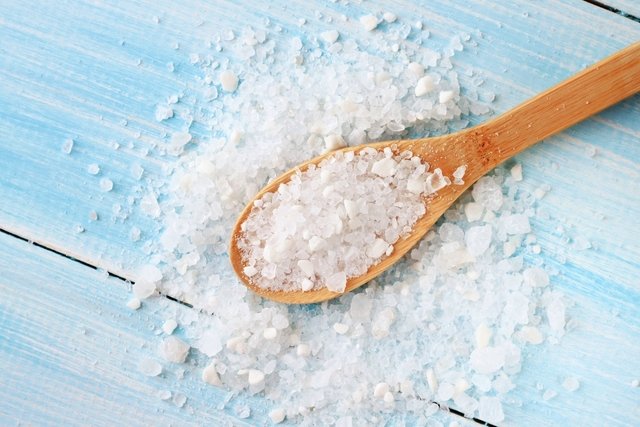Sea salt, or whole sea salt, is a condiment obtained through the natural evaporation of sea water or salt lakes. Because it is rich in sodium, a mineral that balances the quantity and distribution of water in the body, sea salt helps regulate blood pressure.
Additionally, sea salt contains calcium and magnesium, minerals that add flavor and color to this condiment. However, sea salt has the same amount of sodium as other types of salt, such as refined salt and Himalayan salt, and should therefore be consumed in moderation.
Sea salt, also known as whole salt, can be found in supermarkets or health food stores, in the form of fine grains or flakes, which may or may not be fortified with iodine and which vary in color from white, pink, black or gray. .

Main benefits
The main health benefits of moderate sea salt consumption are regulating blood pressure and facilitating the absorption of nutrients. This is because this salt is rich in sodium, a mineral that regulates the amount and distribution of water in the body, in addition to allowing nutrients to enter the cells. Discover other benefits of sodium.
Furthermore, when enriched with iodine, a mineral that is essential for the formation of thyroid hormones, whole salt also regulates thyroid functions, helping to prevent the emergence of problems such as hyperthyroidism and goiter.
Difference between sea salt and refined salt
Refined, or table, salt goes through a refining and bleaching process, where many minerals are also removed. Furthermore, this type of salt also contains anti-humectants, a chemical additive that prevents the formation of moisture, leaving the food with a finer and looser texture.
Sea salt contains the same amount of sodium as refined salt. However, this type of salt does not go through the refinement process, containing slightly more minerals than refined salt. Furthermore, whole salt has no additives and its texture varies between flakes, thick or fine grains.
Nutritional information table
The following table contains nutritional information for 10g, which is equivalent to 2 teaspoons, of sea salt and refined salt:
It is important to remember that sea salt, or whole salt, contains the same amount of sodium as other types of salt, such as refined salt, Himalayan salt or coarse salt. Therefore, this type of salt should also be consumed in moderation.
Recommended quantity
The World Health Organization recommends a maximum intake of 5g of salt, which corresponds to approximately 1 teaspoon of sea salt per day.
This is because excessive salt consumption can cause an increase in blood pressure, increasing the risk of serious heart problems, such as stroke or heart attack.
How to consume
Sea salt can be used to season preparations such as salads, meats, breads, soups, pastas, stews and sauces.
Furthermore, whole salt can also be used to prepare home remedies such as gargles and nasal washes for sinusitis, for example. See how to wash your nose for sinusitis.
See with nutritionist Tatiana Zanin how to consume salt in a healthy, tasty and practical way:
Bibliography
- UNIRIO- FOOD AND NUTRITION SECTOR- DECTOR OF STUDENT AFFAIRS. Sal. 2020. Available at: <http://www.unirio.br/prae/nutricao-prae-1/quarentena/ Carregamento-boletins-setan/Boletim%208_%20SAL_FINAL%202.pdf>. Accessed on October 4, 2022
- GALIOTTO, Giovana et al. Mineral composition of different types of mineral salts. Demetra Food, Nutrition and Health. Vol.15. 51430.ed; 1-11, 2020
- CARAPETO, Cristina et al. Which Table Salt to Choose? . Journal of Nutrition & Food Sciences. Vol.8. 3.ed; 1-4, 2018
- WORLD HEALTH ORGANIZATION. Salt intake. Available at: <https://www.who.int/data/gho/indicator-metadata-registry/imr-details/3082>. Accessed on October 4, 2022
- EUROPEAN FOOD INFORMATION COUNCIL. Sodium: foods, functions, how much do you need and more. Disponível em: <https://www.eufic.org/en/vitamins-and-minerals/article/sodium-foods-functions-how-much-do-you-need-more>. Acesso em 04 out 2022

Sign up for our newsletter and stay up to date with exclusive news
that can transform your routine!
Warning: Undefined array key "title" in /home/storelat/public_html/wp-content/plugins/link-whisper-premium/templates/frontend/related-posts.php on line 12
Warning: Undefined array key "title_tag" in /home/storelat/public_html/wp-content/plugins/link-whisper-premium/templates/frontend/related-posts.php on line 13




